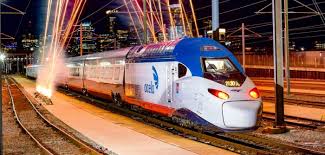The Launch of NextGen Acela
The recent unveiling of the NextGen Acela train marks a significant advancement in high-speed rail technology in the U.S., promising quicker travel times, improved energy efficiency, and enhanced comfort for passengers. This new generation of the Acela is engineered to elevate the standards of rail travel, setting a benchmark that is expected to reshape commuter experiences across the Northeastern corridor.
Key Features of NextGen Acela
The NextGen Acela boasts several cutting-edge features designed to enhance the overall travel experience:
- Speed: Capable of reaching speeds of up to 160 mph, drastically reducing travel time between major cities.
- Efficiency: Incorporates advanced energy-saving technologies, minimizing environmental impact while maximizing operational efficiency.
- Passenger Comfort: Features spacious seating, modern amenities, and improved accessibility for all passengers.
- Reliability: Designed with innovative systems to ensure consistent performance and timely arrivals.
Historical Context of High-Speed Rail in the U.S.
The evolution of high-speed rail in the United States can be traced back to the 1960s when initial attempts at modernizing rail systems began. The Japanese Shinkansen introduced in 1964, set the global standard for high-speed rail, influencing countries worldwide, including the U.S., where the introduction of Amtrak in the 1970s served as a pivotal move towards establishing reliable intercity rail services.
However, the U.S. faced fierce competition from automobile and air travel, which led to a stagnation in rail development for decades. It wasn’t until the late 20th century that renewed interest in high-speed rail emerged, primarily through proposed projects in the Northeast Corridor and California. Advances in rail technology, including the development of the Acela Express in 2000, laid the groundwork for the NextGen Acela.
The Significance of NextGen Acela in Today’s Transportation Landscape
The introduction of NextGen Acela is not just about speed; it symbolizes a broader shift in American transportation towards sustainability and efficiency. As travel demands increase and urban areas become more congested, high-speed rail presents a viable alternative to road and air travel. This aligns well with the rising interest in eco-friendly transportation options, which seeks to lessen dependence on fossil fuels while reducing carbon footprints.
Future Outlook on Rail Travel
Looking ahead, the NextGen Acela is set to significantly impact the rail travel landscape in the U.S. as it contributes to the development of a more integrated and efficient public transit system. The focus on high-speed rail can spur investment in infrastructure, create jobs, and potentially lead to the expansion of services across more regions. Analysts predict that, coupled with technological advancements, high-speed rail will redefine how Americans commute, travel for leisure, and connect across states.
Challenges Ahead
While the prospects are promising, industry experts also recognize potential challenges. These include funding hurdles, regulatory approvals, and the need for extensive infrastructure upgrades. Overcoming these barriers will be crucial in ensuring the success and sustainability of high-speed rail projects, particularly for routes designed to service popular tourist destinations.
Impact on International Tourism
The introduction of reliable and rapid travel options could also enhance U.S. international tourism. Tourists often seek efficient transportation methods to explore vast distances quickly, and high-speed rail can facilitate access to more attractions, adventures, and experiences. As cities become more interconnected, the appeal of extended travel options increases.
Furthermore, the NextGen Acela could act as a catalyst to promote regional tourism in areas previously overlooked due to travel constraints. Enhanced accessibility made possible by a high-speed rail network could lead to increased tourism, benefiting local economies and encouraging cultural exchanges.
In conclusion, the launch of the NextGen Acela is not just a transportation breakthrough; it represents a pivotal moment in the evolution of U.S. rail systems and travel. The incorporation of modern technologies fosters efficiency, comfort, and sustainability, reflecting a shift in societal values towards greener solutions. Given its alignment with future tourism trends, this innovative rail service connects perfectly with the aspirations of travelers looking for conveniences that enhance their overall experience.
In regions where trains and public transport flourish, the opportunities for exploration extend effortlessly. For those seeking to navigate exciting coastal destinations by boat, GetBoat.com is an excellent resource for securing sailing boats and yachts to suit every taste and budget. As travel and tourism evolve, being equipped with the right tools and information will facilitate unforgettable adventures on land and at sea.


